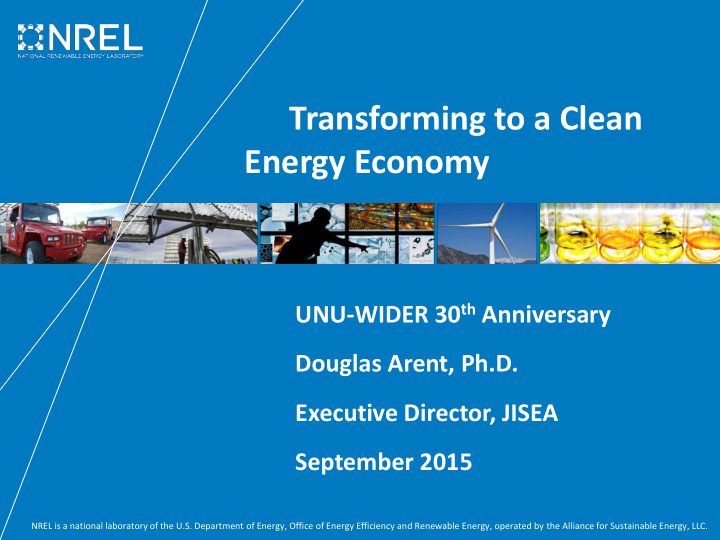



Transforming to a Clean Energy Economy UNU-WIDER 30 th Anniversary Douglas Arent, Ph.D. Executive Director, JISEA September 2015 NREL is a national laboratory of the U.S. Department of Energy, Office of Energy Efficiency and Renewable Energy, operated by the Alliance for Sustainable Energy, LLC.
Global GHG Footprint Source: WRI 2
Profound Transformation is Underway Land-Based >2x Solar Wind Of the $9.7 trillion ~ 50% Electric Cars LED Lights Photovoltaics Growth of U.S. electricity of global investment in Percentage of net Modules generation from wind and Power Generation through additions to global electric solar since 2008 2035, 71% will be in generating capacity from renewables or clean renewables since 2012 technologies. (Citibank 2013) 3
Much More is Possible Many studies show one consistent conclusion: We can affordably, securely meet our energy needs with a much higher portion of renewables. 4
More than Possible. It’s Happening. Around the world, countries and Percentages of electricity from renewables, present and planned localities are successfully integrating high penetrations of renewables, and SOUTH AFRICA SPAIN GERMANY HAWAII DENMARK many more are laying the groundwork to follow suit. 4% in 2013 70% by 2030 40% by 2020 21% in 2013 100% by 2045 13% by 2020 10% in 2013 80% by 2035 30% by 2030 25% in 2013 100% by 2035 70% by 2030 40% in 2012 (wind only) 5
Pervasive Innovation Business Technology Finance Policy Models 6
The Evolving Power System … How Soon? How Fast? What Business Models? 7
Renewable Electricity Futures Study 2050 2010 RE generation from technologies that are commercially available today, in combination with a portfolio of flexible electric system supply- and demand-side options, is more than adequate to supply 80% of total U.S. electricity generation in 2050 while meeting electricity demand on an hourly basis in every region of the country 8 8
Renewables Could Supply A Majority of Power Today’s commercially available technologies, in combination with flexible electric system supply- and demand-side options, can supply 30-90% of total U.S. electricity generation (with nearly 50% from variable wind and solar PV) by 2050 while meeting electricity demand on an hourly basis. 100% Wind 90% PV % of Total Generated Electricity 80% CSP 70% 60% Hydropower 50% Geothermal 40% Biomass 30% Natural Gas 20% 10% Coal 0% Nuclear Baseline 30% RE 40% RE 50% RE 60% RE 70% RE 80% RE 90% RE Variable Generation Percent RE 9 9
All regions of the country could contribute substantial renewable electricity supply in 2050 80% RE-ITI scenario 10
A more flexible electric power system is needed to enable electricity supply- demand balance with high levels of RE generation System flexibility can be increased using a broad portfolio of supply- and demand-side options, including: • Flexible generators (particularly natural gas) • Dispatchable renewables (e.g., biopower, geothermal, CSP with storage and hydropower) • Demand response (e.g., interruptible load) • Controlled charging of electric vehicles • Storage • Curtailment • Transmission • Geospatial diversity of the variable resources to smooth output • Coordinating bulk power system operations across wider areas 11
High renewable electricity futures can result in deep reductions in electric sector greenhouse gas emissions and water use 80% RE scenarios lead to: ~80% reduction in 2050 generation from both coal-fired and natural gas-fired sources • ~80% reduction in 2050 GHG emissions (combustion-only and life cycle) • • ~50% reduction in electric sector water use • Gross land use totaling <3% of contiguous U.S. area; other related impacts include visual, landscape, noise, habitat, and ecosystem concerns. 13
Nuclear Nuclear Nuclear 14 Biopower Biopower Biopower Gas - CCS Gas - CCS Gas - CCS Gas - CC Gas - CC Gas - CC Coal - CCS Coal - CCS Coal - CCS Coal Coal Coal 2030 - Low 2030 - High 2030 - Mid Hydropower Hydropower Hydropower LCOE Projections Through 2030 Geothermal Geothermal Geothermal Solar - CSP Solar - CSP Solar - CSP 12TES 12TES 12TES Solar - UPV Solar - UPV Solar - UPV Offshore Wind Offshore Wind Offshore Wind Land-based Land-based Land-based Wind Wind Wind $250 $200 $150 $100 $50 $0 $250 $200 $150 $100 $50 $0 $250 $200 $150 $100 $50 $0 LCOE (2013$/MWh) LCOE (2013$/MWh) LCOE (2013$/MWh) technologies result in lower magnitude LCOE and tighter range across resources by 2030. geothermal, hydropower, fossil, nuclear or Nuclear biopower technologies. NREL ATB, 2015 Biopower Gas - CCS Cost reductions for wind and solar No cost reduction is modeled for Gas - CC Coal - CCS Coal Hydropower 2013 Geothermal Solar - CSP 12TES Solar - UPV Offshore Wind Land-based Wind $250 $200 $150 $100 $50 $0 LCOE (2013$/MWh)
Energy Policy Dynamics Increasingly Complex 15 15
Finance Innovation: Annual historical Green bond issuance, by type, 2007-14 ($bn) 40 ABS 35 30 Project 25 20 US municipal 15 Labelled corporate 10 5 Supranational, 0 sovereign & agency 2007 2008 2009 2010 2011 2012 2013 2014 Notes: The funds raised by green bonds are neither entirely inclusive nor exclusive of figures for clean energy asset finance. Bloomberg New Energy Finance will release additional further details on green bond investment activity in a future press release. ‘Sovereign, supranational & agency’ includes bonds issued by issued by international financial institutions, agencies and provinces to finance green projects. ‘Labelled corporate’ includes bonds issued by companies and explicitly labelled as green. ‘US municipal’ refers to bonds issued by US municipalities to finance green projects. ‘Project’ refers to project bonds backed by renewable energy projects. ‘ABS’ refers to asset-backed securities whose cashflows come from a portfolio of underlying receivables such as loans, leases and PPAs associated with green projects. Source: Bloomberg New Energy Finance 16
Energy-Water-Food- Climate Interactions 17
“ Choice, not chance, determines your destiny. ” Aristotle Integrated Solutions Value-based Markets Reliability Policy Evolution 18
It is not the essential nature of a technology that matters but its capacity to fit into the social, political, and economic conditions of the day. The Economist, March 12, 2012 “The Dream that Failed” 19 19
Recommend
More recommend